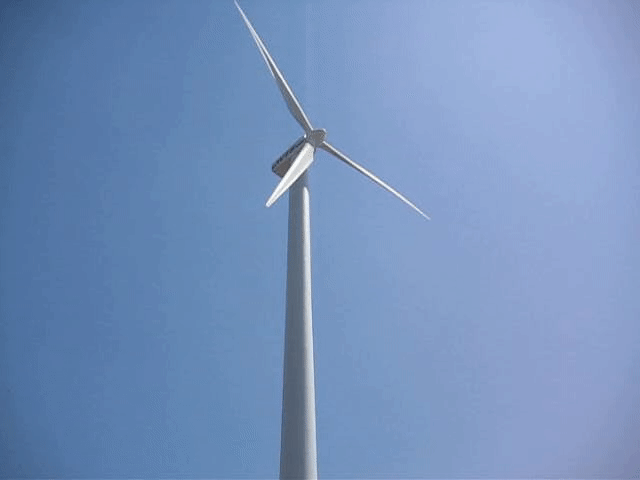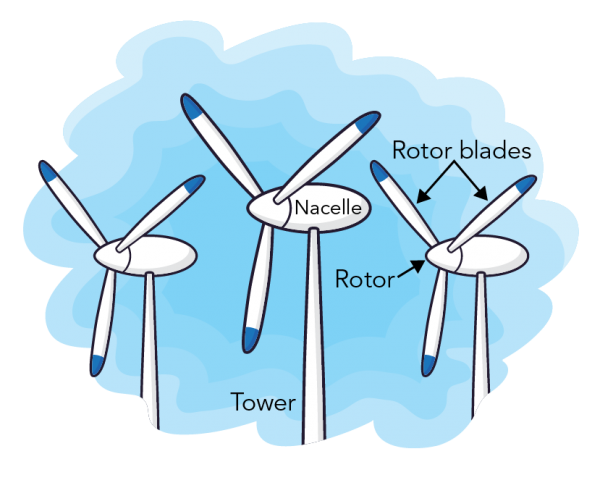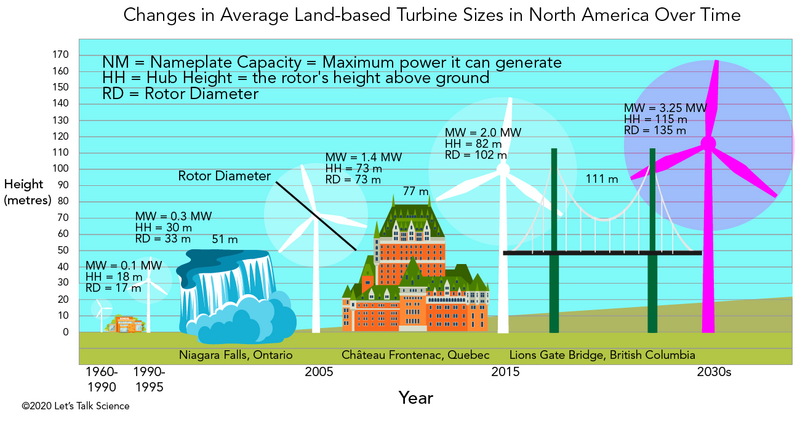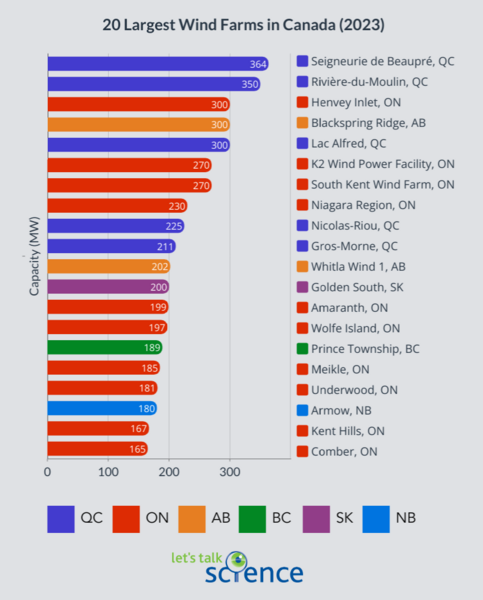Generating Electricity: Wind Power

Wind turbine and electrical cord (Mohamed Hassan, Pixabay)

Wind turbine and electrical cord (Mohamed Hassan, Pixabay)
How does this align with my curriculum?
Learn how moving air can be used to generate electricity.
We can use moving air, or wind, to generate electricity. This is called wind power. In 2021, Canada had the ability to generate 14 300 MW of wind power.
Did you know?
About 5% of the world's electricity comes from wind power.
Wind Turbines
Wind power is usually generated using a wind turbine. Wind turbines are mechanical systems that convert kinetic energy into electrical energy. Kinetic energy is energy that comes from movement. Wind is the movement of air. There are wind turbines on land and in water.

Image - Text Version
Shown is an animated GIF of a wind turbine rotating in blue sky. The camera looks up from the base of the turbine. It is pale grey with a long tapering tower. At the top is a small rectangular box with a conical rotor on the front. Three long, pointed blades stretch out from the rotor. They rotate smoothly and continuously.
Modern wind turbines are complex machines with three main subsystems. These are the rotor and its blades, the nacelle and the tower.
Image - Text Version
Shown is a colour illustration of three wind turbines, with their subsystems labelled. Coming up from the bottom of the illustration are long, white poles that get narrower towards the top. One of these is labelled “Tower.” White capsule shapes with pointed ends sit horizontally on top of the towers. One of these is labelled “Nacelle.” A line divides the point at the front of each nacelle, forming a cone. One of these is labelled “Rotor.” Three long, thin, leaf or wing-shaped structures with blue tips extend outward from each rotor. These are labelled “Rotor blades.”
How a Wind Turbine Works
Click here to access screen-reader friendly PDF
How much power can a wind turbine generate?
That depends on its size. The larger the rotors, the more power the turbine can generate. So it’s probably not a surprise that wind turbines are getting bigger.
The largest wind turbines on land in North America are about 111 m tall. Their rotor blades can stretch to a diameter of 135 m. That’s taller than the Peace Tower at the Parliament Buildings. And the rotor blades reach wider than a football field. Wind turbines found offshore in the ocean can be even larger.
Image - Text Version
Shown is a colour illustrated graph titled “Changes in Average Land-based Turbine Sizes in North America over Time.” The Y axis is labelled “Height (metres).” It goes from 0 at the bottom to 170 at the top. The X axis is labelled “Year” and runs from 1960 on the left, to 2030s on the right. The background of the graph is blue sky and low green hills. White turbines and landmarks are arranged as if they are part of the landscape. In the top left corner, a legend reads “NM = Nameplate Capacity = Maximum power it can generate,” “HH = Hub Height = Hub is where rotors are attached to the nacelle,” and RD = Rotor Diameter.” Starting on the left, the first date mark reads, “1960-1990.” Above, a tiny turbine is labelled “MW = 0.1, HH = 18 m, RD = 17 m.” Next to it, a two storey house reaches a height just below the rotor. The next date mark reads, “1990-1995.” Above, a larger turbine is labelled “MW = 0.3, HH = 30 m, RD = 33 m.” Next to it, an illustration of a waterfall is labelled “Niagara Falls, Ontario, 51 m.” The third date mark reads, “2005.” The diameter of the turbine above is labelled, “MW = 1.4, HH = 73 m, RD = 73 m.” Next to it, an illustration of a large, castle-like building is labelled “Château Frontenac, Québec, 77 m.” The fourth date mark reads, “2015.” The diameter of the turbine above is labelled, “MW = 2.0, HH = 82 m, RD = 102 m.” Next to it, an illustration of a tall green suspension bridge is labelled “Lions Gate Bridge, British Columbia, 111 m.” The final date mark is labelled “2030s.” The turbine above this one is the largest, and bright pink. This is labelled “MW = 3.25, HH = 115 m, RD = 135 m.”
Did you know?
The world’s biggest offshore wind turbine is the Haliade-X. Its rotor blades reach a diameter of 220m and it is 260m tall.
What is a wind farm?
You might see many wind turbines close together. This is called a wind farm. Wind farms can have a few turbines up to several hundred. Canada has a lot of wind farms. Some of these are very large!
Image - Text Version
Shown is a colour bar graph illustrating the total capacity and locations of wind farms in Canada. The title, “20 Largest Wind Farms in Canada (2023)” is in bold letters across the top. The Y axis is labelled “Capacity (MW)” and the X axis is marked from 0 to 400. The bars run horizontally from the Y axis on the left. Each bar is labelled with its name and location, in a column on the right. A legend along the bottom indicates that their colours represent the province where each farm is located. The list reads: Seigneurie de Beaupré, QC, 364 MW; Rivière-du-Moulin, QC, 350 MW; Henvey Inlet, ON, 300 MW; Blackspring Ridge, AB, 300 MW; Lac Alfred, QC, 300 MW; K2 Wind Power Facility, ON, 270 MW; South Kent Wind Farm, ON, 270 MW; Niagara Region, ON, 230 MW; Nicolas-Riou, QC, 225 MW; Gros-Morne, QC, 211 MW; Whitla Wind 1, AB, 202 MW; Golden South, SK, 200 MW; Amaranth, ON, 199 MW; Wolfe Island, ON, 197 MW; Prince Township, BC, 189 MW; Meikle, ON, 185 MW; Underwood, ON, 181 MW; Armow, NB, 180 MW; Kent Hills, ON, 167 MW; Comber, ON, 165 MW.
Advantages of Wind Power
Wind power is called a renewable source of energy. This is because the energy from wind will not run out. Fossil fuels will run out. Wind power is also a clean form of electricity generation. It doesn’t produce greenhouse gases. But greenhouse gases are produced when we manufacture turbines and set them up.
Disadvantages of Wind Power
Wind turbines can only run when the wind is blowing. And they can’t run when the wind is too fast or too slow. To have reliable power when it's needed, this means other electricity sources or forms of electricity storage may be needed alongside wind power.
Some people are concerned that wind turbines may affect human health. They can definitely harm birds and bats, though turbine builders study animal habitats and migratory routes so they cause as little impact on wildlife as possible.
Learn More
How do Wind Farms Affect Birds and Bats? (2019)
This article by Let’s Talk Science explores several ways wind turbines can affect animals.
Weather: Wind (2020)
This backgrounder by Let’s Talk Science explains what causes wind and how we measure it.
Let's Talk Energy - Wind
This article by Ingenium traces the history of wind power and its challenges and opportunities in future.
Wind turbine (2019)
This essay with video (9:53 min.) illustrates the parts of a turbine.
References
American Institute of Physics. (2019 August 13). Growth of wind energy points to future challenges, promise. TechXplore.com.
Canada Energy Regulator. (2019 November 6). Market Snapshot: Wind turbines in Canada have increased in both size and generation capacity.
Canadian Renewable Energy Association. Wind. Solar. Storage.
Energy Education. (n. d.). Wind Turbine.
Natural Resources Canada. (2020 October 6). Renewable energy facts.
North American Clean Energy. (2022, June 09). 3.4 Million Homes in Canada Already Use Only Wind Generated Power.
Wiser, R., Hand, M., Seel, J., and Paulos, B. (2016 November). Reducing Wind Energy Costs through Increased Turbine Size: Is the Sky the Limit? Berkeley Lab Electricity Markets and Policy Group.


